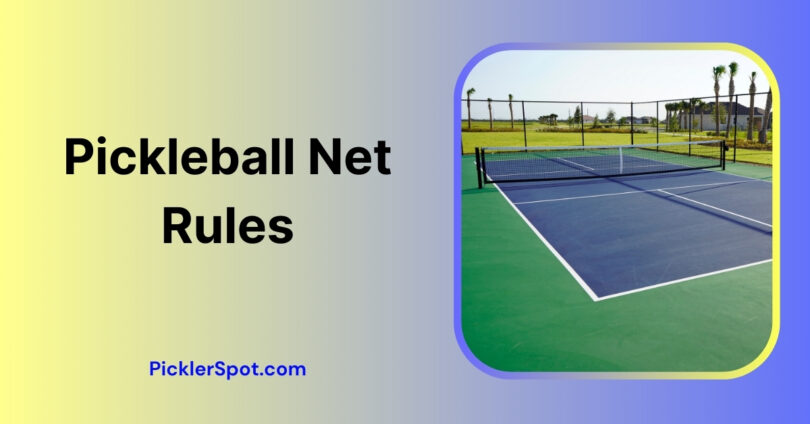When I first started playing pickleball, it felt like a fresh breath of air, considering the fact that I have always been more of a racket sports person, the gameplay felt unique yet intuitive, maybe it had something to do with its easy-to-pick-up rules and techniques.
However, I do have to admit that Pickleball net Rules certainly are a whole different ballgame which is why it felt so challenging to keep track of, especially without a mentor, however, with a little practice, they become second nature.
But that was a long time ago and if you are also having a rough time like me, don’t break a sweat because you do not have to go through it the hard way as I have curated a compendium of rules involving the net used in Pickleball, so you can avoid those initial frustrations and focus on the fun parts.
Understanding The Measurements Of Pickleball Net
In Pickleball, the net isn’t just a physical obstacle or something to hit over but rather it’s a strategic tool and you have to use it wisely and accordingly all while understanding its key influence over the pace of the game. Here are its essential components that you should be aware of before stepping into the court.
Net Height Dimensions
Given the nature of the sport, the pickleball net is considerably high and measures 36 inches at the sidelines all while being 34 inches in the middle or center region, allowing it to have a little bit of curvature or a droop which adds an element of strategy to the game through the introduction of unique challenges and opportunities around the non-volley zone.
Net Width Dimensions
The net itself covers pretty much the whole court and even spans an impressive 22 feet in width which means that the net extends from one sideline to the other, effectively dividing the court into two equal halves.
Mesh Hole Size & Band
Obviously, there is also the probability of the ball escaping through the mesh hole, which is why to prevent this issue, the mesh of the net is made from a nylon material which maintains its integrity throughout the weather due to higher weather resistance and has a hole that is much smaller than the pickleball itself and measures no larger than 2 inches (5.1 cm).
The mesh even has a high-visibility white band, typically made of vinyl or nylon, that runs along the top edge of the net for improved visual clarity for both players and referees. This band often measures 2 inches wide (5.08 cm) and incorporates a cord or cable for structural support within the binding.
Pickleball Net Rules
There are several net rules that you adhere to, failure to do so will result in a fault.
- Ball Interaction with the Net Rule
In Pickleball, a ball when hit by a player must land on the other side, which is usually the opponent’s playing field, and once the opponent returns the ball back to the first player to keep the game going. However, If the serve hits the net and lands in the correct service box, it’s a “let” and the server gets another try.
Anything other than that, such as the ball going completely out of bounds or simply not making the other side of the net at all certainly violates the ball interaction rule for the Pickleball net and will undoubtedly trigger a fault.
Similarly, during a rally, a ball is termed as “live” if it hits the net and lands on the corresponding side of the net, this allows the rally to be carried out without being interrupted.
- Serving Rules For The Pickleball Net
Once the session initiates, the serve must be performed underhand in this fashion, the paddle is kept right below the waist. once the server is executed, the ball must land directly on the other side of the court without making any contact with the net.
However, a lucky bounce is possible in scenarios when a ball happens to touch the net but lands in bounds on the opponent’s side, this phenomenon is automatically termed as “let serve” and the server gets to try again. On the other hand, if it hits the net and doesn’t clear it at all, it’s a fault and the server loses the point.
- Net Rules For Player Crossing
A player cannot cross the plane of the net before striking the ball with the paddle, changing sides before hitting the ball results in a fault as it directly violates this rule.
However, you can cross the plane once the ball is struck either the paddle or part of the body as long as the player hitting the ball doesn’t touch the net directly or the permanently fixed post that is supporting the net which may also result in a fault. The part of the body also includes belongings such as a hat, wallet, watch, glasses, etc which may protrude or extend past the net plane before making contact, then it is a fault, and you (and your team) lose the rally.
Keep in mind that this rule has no exception, except in the rare case where extreme backspin causes the ball to bounce back over the net after hitting it or when the ball trajectory is manipulated by strong wind gusts which which causes it to behave unexpectedly and potentially land on the server’s side.
On some rare occasions, a ball might revert back to the server side after the ball is deflected by an unusual object on the court such as a bird unexpectedly flying through the court’s airspace, a stray leaf, a loose pebble, or unexpected debris. There are also some instances where a foreign object, like a forgotten hat or water bottle, might find its way onto the court. But don’t worry, the referee will be there to deal with any such surprises and ensure a fair game!
- Non-Volley Zone (NVZ) Net Rule
The NVZ better known as the Non-volley zone is the sovereign region of the pickleball and the zone that demands strategic footwork and careful decision-making. Therefore, players must never hit a volley when standing in this zone as it will result in a fault even if it makes it past the net without touching it with just one exception though as you can volley a ball that has already bounced in the NVZ.
Common Mistakes to Avoid When Setting Up a Pickleball Net
These are the types of oversights you clearly need to be aware of as it usually committed by both rookies and professional players, nevertheless, they could be easily avoided if you are careful enough as they usually play a huge role in being a culprit behind Pickleball net rules violation.
- Misalignment In The Post
As weird as it may sound, even though the dimension might be correct, there are usually chances the posts are either crooked or bent which causes the misalignment issues that cause the net to either be sagging or have a strange droop in weird places, potentially leading to unfair advantages or disadvantages during gameplay.
what’s even worse is that it creates confusion around the rules, leading to potential disputes over net faults, so instead of focusing on the rules, it’s best that you first address the alignment of your posts before carrying out a session.
- String or Cable Tension Issues
More often than not, a net fault is triggered because the cable or string that has hooked the net in place is usually either too lose or simply way too tight on one spot, which introduces unnecessary inconsistency and makes rallies so much harder to judge fairly, causing potential disagreements among players.
On the other hand, players who have already built up hand-eye coordination cannot play to their full potential, as they have to adjust to an unpredictable net all while being forced to second-guess the ball’s trajectory in that case net becomes an obstacle rather than a tool.
- Unstable Net
Playing in windy or harsh weather outdoors can be a headache to deal with but playing with a net that is unstable due to lack of anchoring or support is a nightmare waiting to happen, even for the most experienced players.
Nobody likes to play with a net posts wobbling around on its axis, so it’s crucial to invest in a quality net with a sturdy support system to avoid unnecessary distractions and frustrations. If you already have a premium-grade net, take a few extra minutes to make sure your net is stable and safe before starting a game, this is extremely helpful because it could save you from a massive headache and even prevent a potential hazard in the court that might injure anyone.
- Visibility Factor
If you are playing in a private court, it is best that you mark the net with a contrasting strip of fabric to make the center easily visible. This is extremely helpful in scenarios where you have poor visibility due to a lack of ambiance lightning.
Nevertheless, not only will it help you track the rules of the net much more accurately but will also give the referee who is monitoring the match a better vantage point for making accurate net fault calls. Your pickleball life would also be much smoother if net rules are enforced which ensures fair play for everyone.
Final Word
As the saying goes “Practice makes perfect” and if you are willing to put your focus and commitment to the game all while following my helping hand like my brief guide of Pickleball Net Rules you will be confidently navigating the court and winning points.
But then again, it also boils down to the fact how often you’re able to hit the courts and play along with your buddies and peers, after all, reading alone wouldn’t do you any good – theory needs to be put into practice.
So what are you waiting for? Get out there, practice what you’ve read and learned from my guide, and become a pickleball star!









